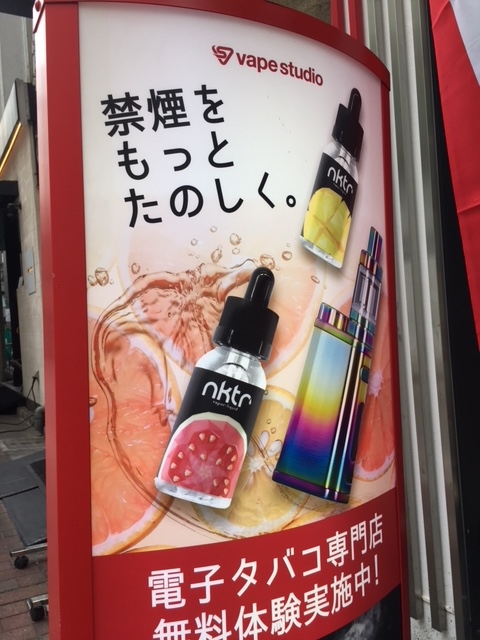The vapid folly of vaping
It was bound to happen. Someone in Osaka rigged a vape device for nicotine delivery, which is the main purpose for most vape devices around the world but puzzlingly illegal in Japan.
On March 26, Osaka prefectural police reported that the owner of a vape store in Hirakata City, made nicotine liquid for a vape device. He was charged on suspicion of violating Pharmaceuticals and Medical Devices law. If he was gonna get busted, he might as well have tried cannabis.
Legal vaping in Japan, for now, is the inhalation of a flavored and scented glycerin vapor. While vape store owners are happy to boast of the wide range of flavors on offer they are distressingly vague on what chemicals compose the vapor source. The best answer we got on the composition of the vape juice, from a local proprietor, was either vegetable glycerin or propylene glycol and some flavoring agents.
Among the 300 flavors at the Vape Studio near my office in Ginza are Red Bull, Coca-Cola, Aloe Vera, Grilled Beef, Kimchee and Collagen. Collagen? Don’t ask. Flavor cartridges start at 1,000 yen each while vape devices range from 3,000 to 10,000 yen and up.
Give me an order of kimchee with a side of formaldehyde
Before you start dreaming of a post-lunch kimchee vape, let’s go back to what else is in that glycerin and propylene glycol in the vapor. According to an April 5 article in the New York Times, formaldehyde, a known carcinogen, is generated when propylene glycol or glycerin is heated for vaping. And it’s not a small amount. A study published in the journal “Environmental Science and Technology” reported that the formaldehyde coming out of a vape device or e-cigarette exceeds “ceiling limits,” or a level that is not even allowed in the atmosphere for one second. Suddenly nicotine is sounding very healthy.
Hold on, that’s not all. Did you ever wonder why microwave and movie theater popcorn has that strange smell? Sure it tastes good and kinda buttery, but you know something’s a little off. The flavor comes from a chemical called diacetyl, which is safe to eat but not to inhale. That’s why people working in factories where that fake butter flavor is created started coming down with lung problems or a condition lovingly nicknamed “popcorn lung.” They were inhaling too much diacetyl. Guess what? Diacetyl is also used to create all sorts of flavors, such as strawberry, piña colada, and butter scotch. It should come as no surprise then that U.S. researchers found diacetyl in fumes from 75% of the vape devices they tested.
With diacetyl getting a bad rap, some U.S. vape makers are shifting to something called 2,3-pentanedione to produce some of the 7,000 flavors marketed for vape devices. According to the same NY Times article, about 50% of vape devices tested positive for 2,3-pentanedione. That’s OK right? Well, according research based on animal testing that chemical can cause something similar to…wait for it…popcorn lung.
Would you like butter flavor with your popcorn lung?
We can only assume that Japanese health officials believe that getting popcorn lung or inhaling formaldehyde is not as bad as inhaling nicotine, (not to mention all the chemicals that go with conventional smoking). But it's not like Japan is officially against smoking or nicotine. While the tide is slowly turning toward smoke-free public spaces, many bars and restaurants still allow smoking and legislation to ban smoking in such places before the 2020 Olympics has been derailed and watered down on the twisted logic that it would hurt the sales of smaller establishments.
At the same time, Japanese consumers are eagerly shifting to non-cigarette nicotine delivery systems. In fact, the e-cigarette market is exploding, and some tobacco industry estimates suggest that sales may soon surpass regular cigarettes. Just take a gander into any alleyway or park in Tokyo, and you’ll see someone puffing away on an e-cig. Several e-cigarette devices are being heavily marketed, including IQOS, a Philip Morris product, and Glo produced by British American Tobacco (BAT). In fact, IQOS has a well-appointed shop in Ginza that resembles a fine jewelry store, complete with comfortable seating and attractive sales people.
The difference between these e-cig devices and vapes, however, is as foggy as a hookah bar. Both products purport to “heat” rather than burn tobacco. Perhaps the best distinction, is that e-cigs heat a tobacco unit, composed of tobacco leaves while vapes fire up a liquid cartridge. Most importantly, in Japan, e-cigs are for nicotine while vaping is not. However, another product that recently entered the market is straddling the fence between vaping and e-cigarettes.
Make room for the Ploom
Enter Ploom Tech. Japan Tobacco (JT) developed Ploom Tech products after acquiring the technology patents from a San Francisco start-up. It’s billed as a hybrid between a heated tobacco product and a vaporizer. Thin and shaped like a pen, the device looks like any other vape device. However, according to JT, it heats a non-nicotine liquid, which passes through a capsule containing granulated tobacco to deliver good old nicotine to the smoker. JT is promoting Ploom as a near odorless smoking device, thus less offensive the IQOS and Glo and much less offensive than conventional cigarettes. And that's the key. No combustion. No ash. No offense.
With the smoking public clamoring for offense-free smoking options, I suppose it’s only a matter of time before JT figures out a way to monetize nicotine liquid for vape devices. Remember, in Japan it’s not really important whether you hurt yourself or not, as long as you don’t raise a stink and offend others. But don’t hold your breath on smoke-free bars and restaurants, that cloud has yet to be cleared.
















